Frequently Asked Questions (F.A.Q.)
Q:
What is Frozen Semen?
A:
Canine semen can be collected and preserved with state of the art extender products to provide necessary nutrients and cryoprotectants to the sperm cells during the process of chilling, freezing in liquid nitrogen vapors and then in liquid nitrogen itself.
Q:
Why should I freeze semen on my dog?
A:
-
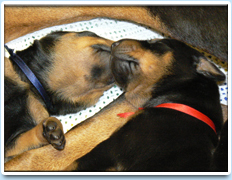 Preserving your dog(s) genetic potential, in case of disease, infertility or untimely death.
Preserving your dog(s) genetic potential, in case of disease, infertility or untimely death.
-
Freezing semen on a young performance dog prior to neutering him leaves options open for future offspring.
Q:
Why use frozen semen?
A:
-
Distance of stud dog to the bitch. Ship the semen not the bitch!
-
Import/exporting dogs from distant gene pools (International breeding) allows access to a wider, more varied gene pool.
-
Bringing back successful Breed/Performance dogs who are no longer alive, or long past their breeding life
-
Preserving genetic selection. Dipping back into a gene pool before a particular genetic defect became apparent in a breeding line.
Q:
At what age can a dog have semen collected and frozen?
A:
The younger the dog the better the semen quality! Any time after 10 months of age we can collect semen and freeze the sample.
Q:
How frequently can I bring my dog in for semen freezing?
A:
Once a week if the dog is not being used actively at stud. If a dog is being bred, we suggest waiting 2 weeks before having him collected and frozen.
Q:
Do I have to use a "teaser" bitch for collection?
A:
Using a teaser bitch assures the best quality and quantity sample for freezing.
Q:
What if my dog is not used to being collected and isn't comfortable?
A:
An injection of Prostaglandin can be given 15 minutes prior to collection. This will cause the dog to ejaculate a very concentrated sample! It has been our experience that most dogs are fine on subsequent collections.
Q:
Do I have to "clean out my dog" if he hasn't been collected for a while?
 A:
Dogs don't tend to "build up" semen and will retroejaculate into their bladder. There is, however, some discussion amongst Theriogenologists on this topic. We have collected many "virgin" dogs with excellent semen quality, but if we find the fresh sample to be less than desirable, we will ask you to bring the dog back in an hour and collect again, or schedule you for another appointment.
A:
Dogs don't tend to "build up" semen and will retroejaculate into their bladder. There is, however, some discussion amongst Theriogenologists on this topic. We have collected many "virgin" dogs with excellent semen quality, but if we find the fresh sample to be less than desirable, we will ask you to bring the dog back in an hour and collect again, or schedule you for another appointment.
Q:
How long can semen be stored before it is no longer "usable"?
A:
Frozen semen is good indefinitely! Cryopreservation will keep your dog's semen viable forever, which is why it is a good investment for any breeder who wishes to preserve a gene pool indefinitely.
Q:
Do I need to have my dog DNA tested?
A:
The AKC requires all dogs to have a DNA profile. We can obtain a DNA cheek swab at the time of collection.
Q:
Who pays for semen when it is shipped?
A:
Typically the bitch owner who is purchasing the semen pays for shipping.
Q:
Can I use frozen semen for vaginal insemination instead of surgical?
A:
Unlike fresh semen, which can live in the reproductive tract of a bitch for 5-7 days, frozen semen will only live 12-20 hours once thawed. It must preserve all it's energy to penetrate and fertilize the eggs, so the best conception rates (90% in our practice) are achieved with surgical insemination, where the semen is injected directly into the uterine horn. Since vaginal insemination has statistically low conception rates (under 20%), we do not suggest using your valuable semen in this fashion.
Q:
What happens if you lose electricity at your facility?
A:
Liquid nitrogen requires no electricity. All tanks are kept in a locked room and checked regularly by us to assure adequate levels of liquid nitrogen are present at all times.
Q:
What kind of litter size can I expect from a surgical insemination?
A:
Quality of the semen and timing of the bitch are key elements for success with using frozen semen. The largest litter we have had from a frozen semen insemination was a litter of 13 Irish Wolfhound puppies from semen that was frozen 10 years ago!
Q:
What is the difference between freezing in straws or pellets?
A:
Though there is little difference in the quality of semen frozen in straws vs. pellets, we choose to use straws for ease of thawing and superior identification. Each straw has identifying information unique to that particular dog (Inset, upper left). If a straw floated up in a storage tank, we could easily identify the individual dog. The straws are stored in labeled goblets (Inset, lower left) that are snapped onto a labeled cane (Inset, lower right). Pellets are stored in a small plastic vial (Inset, upper right). Though the vial itself is labeled, the pellets have no identifying information on them. If the cap should come loose on the vial, you would not know which dog the pellets came from.
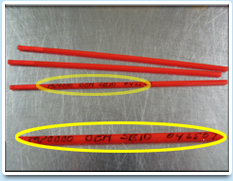
|
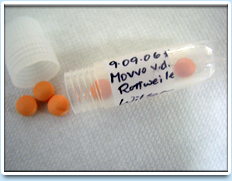
|
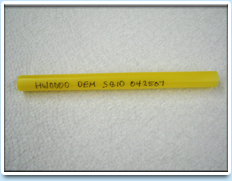
|
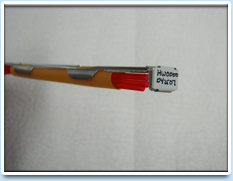
|
Q:
How many straws should you use for one insemination?
A:
The number of straws required per insemination is determined by thawing a straw and rating its post thaw motility. For a frozen semen breeding you want to have a minimum of 100 million motile sperm per insemination. Each straw holds 50 million sperm but not all of them will survive the freezing process, hence the evaluation of "post thaw motility". The higher the percent post thaw motility the fewer straws are required. For example; if a sample is rated at a 70% post thaw motility, of the 50 million sperm in the straw 35 million will have survived the freezing process, so in order to get at least 100 million motile sperm you would need to use 3 straws (3 X 35 million = 105 million motile sperm).



